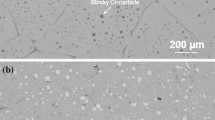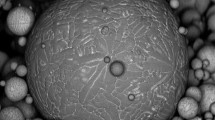Abstract
Co-Re-based alloys have been developed to supplement the Ni-base superalloys used in gas turbine applications at high temperatures (1473 K [1200 °C] bare metal temperature). Unlike other commercial Co-based alloys, the Co matrix in the Co-Re alloys has a stable hexagonal close-packed (hcp) structure at room temperature. In situ neutron diffraction measurements on experimental Co-Re alloys hardened by carbide precipitates showed that the matrix undergoes an hcp ⇆ face-centered cubic (fcc) allotropic transformation after heating to high temperatures. Furthermore, it was found that this transformation has a large hysteresis (~100 K). Thermodynamic calculations were undertaken to study the high-temperature phase stability and transformations in the complex multicomponent, multiphase Co-Re-Cr-C system with or without the addition of Ta. The results show that the minor phases (Cr23C6-type carbides and the Cr2Re3-type σ phase) play an important role in the hcp ⇆ fcc hysteresis by influencing the partitioning of Cr and Re between the matrix and the other phases.









Similar content being viewed by others
Notes
An isopleth is a phase diagram where the tie lines are not in the plane of the diagram and where at least one extensive variable, normally a composition, is fixed. The isoplethal sections are a special case of the vertical section.
References
C. Montero-Ocampo, R. Juarez, and A.S. Rodriguez: Metall. Mater. Trans. A, 2002, vol. 33A, pp. 2229–35.
K. Oikawa, G.-W. Qin, T. Ikeshoji, R. Kainuma, and K. Ishida: Acta Mater., 2002, vol. 50, pp. 2223–32.
C. Hitzenberger and H.P. Karnthaler: Philos. Mag. A, 1991, vol. 64, pp. 151–63.
S.K. Sahay and B. Goswami: Solid State Phenom., 2009, vol. 150, pp. 197–219.
Y. Liu, H. Yang, G. Tan, S. Miyazaki, B. Jiang, and Y. Liu: J. Alloys Compd., 2004, vol. 368, pp.157–63.
J.W. Christian: The Theory of Transformations in Metals and Alloys, Pergamon Press, Oxford, UK, 1985, p. 94.
G.B. Olsen and M. Cohen: Dislocations in Solids, F.R.N. Nabarro, ed., North-Holland, Amsterdam, the Netherlands, 1986, vol. 7, p. 295.
J. Rösler, D. Mukherji, and T. Baranski: Adv. Eng. Mater., 2007, vol. 9, pp. 876–81.
E.M. Sokolovskaya, M.L. Tuganbaev, G.I. Stepanova, E.F. Kazakova, and I.G. Sokolova: J. Less-Common Met., 1986, vol. 124, pp. L5–L7.
M. Hofmann, R. Schneider, G.A. Seidl, J. Kornmeier, R. Wimpory, U. Garbe, and H.G. Brokmeier: Physica B, 2006, vols. 385–368, pp. 1035–37.
R. Gilles, M. Hoelzel, M. Schlapp, F. Elf, B. Krimmer, H. Boysen, and H. Fuess: Z. Kristallogr. Suppl., 2006, vol. 23, pp. 183–38.
Berlin Neutron Scattering Center: U.S.E. Handbook, 2000b, http://www.hmi.de/bensc/sample-env/USE20004.pdf.
D. Mukherji, M. Klauke, P. Strunz, I. Zizak, G. Schumacher, A. Wiedenmann, and J. Rösler: Int. J. Mat. Res., 2010, vol. 101, pp. 340–48.
D. Mukherji, P. Strunz, R. Gilles, M. Hofmann, F. Schmitz, and J. Rösler: Mater. Lett., 2010, vol. 64, pp. 2608–11.
H.L. Lukas, S.G. Fries, and B. Sundman: Computational Thermodynamics, Cambridge University Press, 2007.
B. Sundman, B. Jansson, and J.-O. Andersson: CALPHAD, 1985, vol. 9, pp. 153–90.
A.I. Gusev, A.S. Kurlov, and V.N. Lipatnikov: J. Solid State Chem., 2007, vol. 180, pp. 3234–46.
A.I. Gusev, A.A. Rempel, and A.J. Magerl: Disorder and Order in Strongly Non-Stoichiometric Compounds, Springer, Berlin, Germany, 2001, p. 455.
H. Okamoto: J. Phase Equilib., 2003, vol. 24, pp. 377–78.
T.B. Massalski: Binary Alloy Phase Diagrams, ASM International, Materials Park, OH, 1986, vol. 1, p. 793.
Acknowledgments
Financial support from the Deutsche Forschungsgemeinschaft for the research project “Beyond Nickelbase Superalloys” is gratefully acknowledged. One author (P. Strunz) acknowledges support from the AV0Z10480505 project and the MPO project FR-TI1/378.
Author information
Authors and Affiliations
Corresponding author
Additional information
Manuscript submitted August 27, 2010.
Rights and permissions
About this article
Cite this article
Mukherji, D., Strunz, P., Piegert, S. et al. The Hexagonal Close-Packed (HCP) ⇆ Face-Centered Cubic (FCC) Transition in Co-Re-Based Experimental Alloys Investigated by Neutron Scattering. Metall Mater Trans A 43, 1834–1844 (2012). https://doi.org/10.1007/s11661-011-1058-4
Published:
Issue Date:
DOI: https://doi.org/10.1007/s11661-011-1058-4




